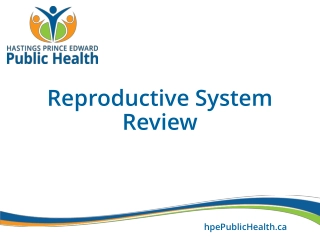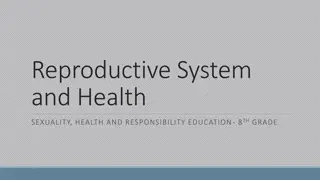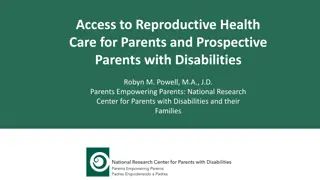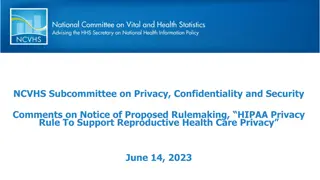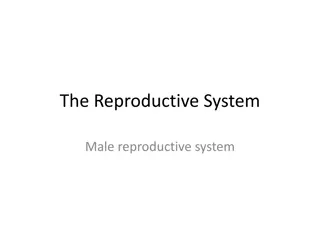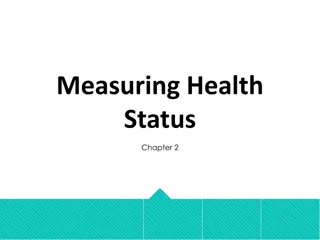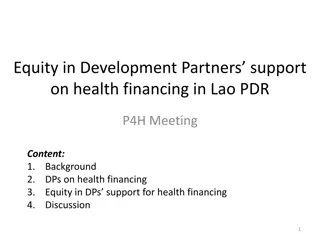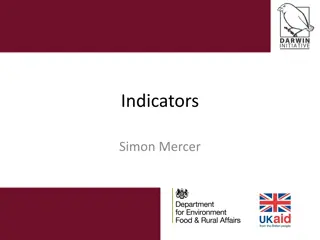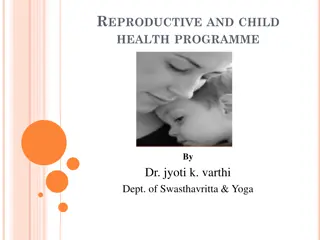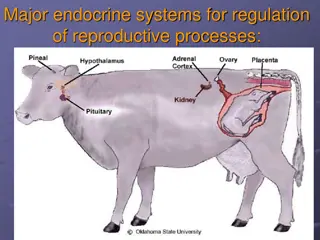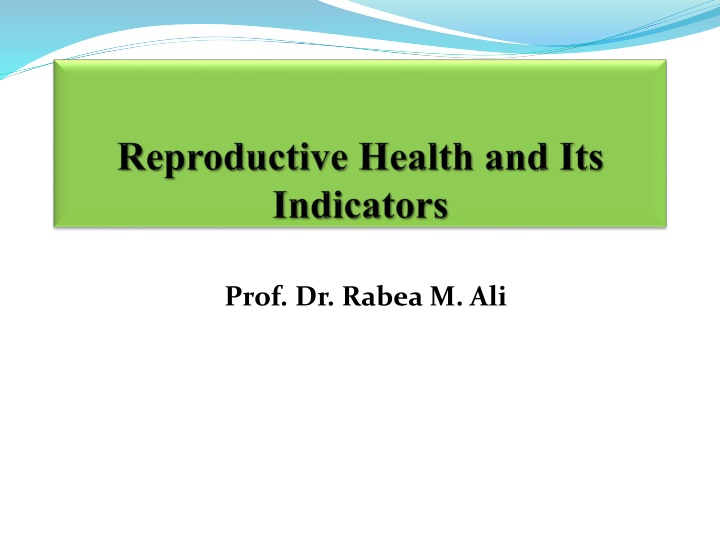
Comprehensive Reproductive Health: Services and Indicators
"Explore the comprehensive aspects of reproductive health, including counseling, safe motherhood, gynecological care, and national health indicators like total fertility rate. Learn about the importance of reproductive health services in promoting well-being across all stages of life."
Download Presentation

Please find below an Image/Link to download the presentation.
The content on the website is provided AS IS for your information and personal use only. It may not be sold, licensed, or shared on other websites without obtaining consent from the author. If you encounter any issues during the download, it is possible that the publisher has removed the file from their server.
You are allowed to download the files provided on this website for personal or commercial use, subject to the condition that they are used lawfully. All files are the property of their respective owners.
The content on the website is provided AS IS for your information and personal use only. It may not be sold, licensed, or shared on other websites without obtaining consent from the author.
E N D
Presentation Transcript
Providing an overview of reproductive health Reproductive health affects the lives of women and men from conception to birth, through adolescence to old age, and includes the attainment and maintenance of good health as well as the prevention and treatment of ill health Reproductive health services cover a wide range of programmed areas.
Comprehensive reproductive health care includes: 1- Counseling , information, education , communication and clinical services in family planning; 2-Safe motherhood, including antenatal care, safe delivery care (skilled assistance for delivery with suitable referral for complications) and postnatal care, breastfeeding and infant and women s health care women with obstetric
3-gynaecological care, including prevention of abortion, treatment of complications of abortion, and safe termination of pregnancy as allowed by law; 4- prevention and treatment of sexually transmitted diseases (including HIV/AIDS), including condom distribution, universal precautions against transmission of blood borne infections, voluntary testing and counseling;
Generation, interpretation and analysis of the shortlisted national reproductive health indicators 1 -Total fertility rate The number of births a woman would have by the end of her reproductive life if she experienced the currently prevailing age- specific fertility rates from age 15 to 49 years
The age-specific fertility rate (ASFR) is derived as follows: ASFR= Births in year to women aged X/ No. of women aged X at mid- year per 1000 women, the total fertility rate per woman can be :computed as follows
TFR = (per woman ASFRs x 5/1000) Age- specific fertility rates are defined using the number of women in each age group and the number of births to women in that age group. Women of reproductive age refers to all women aged 15 49 years.
2- Contraceptive prevalence The proportion of women of reproductive age who are using (or whose partner is using) a contraceptive method at a given point in time. Numerator: Number of women of reproductive age at risk of pregnancy who are using (or whose partner is using) a contraceptive method at a given point in time Denominator: Number of women of reproductive age at risk of pregnancy at the same point in time
3-Maternal mortality ratio The number of maternal deaths per 100 000 live births Numerator: All maternal deaths occurring in a period (usually a year) Denominator: Total number of live births occurring in the same period
4 -Antenatal care coverage The proportion of women attended, at least once during their pregnancy, by skilled health personnel for reasons relating to pregnancy Numerator: Number of pregnant women attended, at least once during their pregnancy, by skilled personnel for reasons related to pregnancy during a fixed period Denominator: Total number of live births during the same period
5 -Births attended by skilled health personnel The proportion of births attended by skilled health personnel Numerator: Births attended by skilled health personnel during a specified period Denominator: Total number of live births during the specified period Generation, interpretation and analysis...
6-Availability of basic essential obstetric care and availability of comprehensive essential obstetric care Two process indicators related to the availability of essential obstetric care are recommended as assessment tools to gauge national and global progress in reduction of maternal mortality:
Definitions of important terms A basic essential obstetric care (BEOC) facility is one that performed all of the following six services (known as signal functions) at least once in the previous three months: administration of parenteral antibiotics, oxytocic's and anticonvulsants; manual removal of the placenta; removal of retained products (e.g. manual vacuum aspiration); and assisted vaginal delivery (vacuum extraction or forceps. The recommended minimum acceptable level is four BEOC facilities per 500 000 population.
A comprehensive essential obstetric care CEOC) facility is one that has performed surgery (caesarean section) and blood transfusion, in addition to all six BEOC services, at least once in the previous three months. The recommended minimum acceptable level is one CEOC facility per 500 000 population.
It is important to notice that these definitions explicitly impose the condition of functioning facilities. Distinction is madebetween facilities that are actually functioning and those that may have the equipment but nevertheless may not be performing as such.
Availability of basic essential obstetric care (BEOC) The number of facilities with functioning basic essential obstetric care per 500 000 population Numerator:Numberoffacilities with functioning basic care X 500 000 Denominator: Total population )
Availability of comprehensive essential obstetric care (CEOC) The number of facilities with functioning comprehensive essential obstetric care per 500 000 population Numerator: Number of facilities with functioning basic care X 500 000 Denominator: Total population
8- Perinatal mortality rate The number of perinatal deaths per 1000 births Numerator: Number of perinatal deaths (fetal deaths and early neonatal deaths) x 1000 Denominator: Total number of births
9 -Prevalence of low birth weight The percentage of live born babies who weigh less than 2500 g Numerator: Number of live born babies who weigh less than 2500 g x 100 Denominator: Total number of live births
10 -Prevalence of positive syphilis serology in pregnant women The percentage of pregnant women aged 15 24 years attending antenatal clinics with a positive serology for syphilis. Numerator: Number of pregnant women aged 15 24 years attending antenatal clinics, whose blood has been screened for syphilis, with a positive serology for syphilis during a specified period x 100. Denominator: Total number of pregnant women aged 15 24 years attending antenatal clinics, whose blood has been screened for syphilis during the specified period
11- Prevalence of anemia in women The percentage of women of reproductive age screened for haemoglobin levels who have levels below 110 g/l (pregnant women) and 120 g/l (non- pregnant women). Numerator: Number of women of reproductive age screened for haemoglobin levels who have levels below 110 g/l (pregnant women) and 120 g/l (non- pregnant women) during a specified period x 100 Denominator: Total number reproductive age screened for haemoglobin levels during the specified period of women of
12- Percentage of obstetric and gynecological admissions owing to abortion The percentage of admissions for (spontaneous or induced) abortion-related complications to service delivery points providing inpatient obstetric and gynecological services, among all admissions (except those for planned termination of pregnancy) Numerator: Admissions for abortion-related complications x100 Denominator: All admissions, except those for planned termination of pregnancy
13- Reported prevalence of women with genital mutilation The percentage of women interviewed in a community survey who report having undergone genital mutilation . Numerator: Number of women interviewed in a community survey who report having undergone genital mutilation x100 Denominator: Total number of women interviewed in the survey
14- Prevalence of infertility in women The percentage of women of reproductive age (15 49 years) at risk of becoming pregnant (not pregnant, sexually active, not using contraception and not lactating) who report trying for a pregnancy for two years or more . Numerator: Number of women of reproductive age (15 49 years) at risk of becoming pregnant (as defined above) who report trying unsuccessfully for a pregnancy for two years or more x100 .Denominator: Total number of women of reproductive age at risk of becoming pregnant
15- Reported incidence of urethritis in men The percentage of men aged 15 49 years, interviewed in a community survey, who reported having one or more episodes of urethritis in the previous 12 months Numerator: Number of men aged 15 49 years who reported having one or more episodes of urethritis in the previous 12 months x 100 .Denominator: Number of men aged 15 49 years interviewed in the survey
16- Prevalence of HIV infection in pregnant women The percentage of blood samples taken from women aged 15 24 years that test positive for HIV during routine sentinel surveillance at selected antenatal clinics Numerator: Number of HIV-positive blood samples taken from pregnant women aged 15 24 years*
at selected antenatal clinics (sentinel surveillance sites) x 100 Denominator: Total number of blood samples taken from pregnant women aged 15 24 years from selected antenatal clinics that were tested for HIV *In the immediate post-pubertal age group (i.e. the age group just beginning sexual activity virtually all prevalent infections could be used as proxy for incident (new) infections

